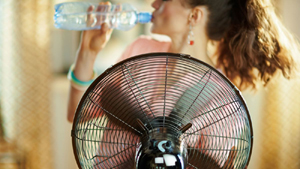Wednesday September 15, 2021 | VICTORIA, BC
Editorial by Mary P Brooke, B.Sc., Editor | Island Social Trends
Heat domes like the one experienced in British Columbia for five days in June 2021 is something that is likely to happen again, and not decades from now.
Today during a heat wave information session for municipal leaders as part of the 2021 Union of BC Municipalities convention (held online), meteorologist and science reporter Johanna Wagstaffe retold a condensed version of how weather experts confidently forecast a serious heat dome at least one week before it happened.

Some sectors of the public listened to that, and as individuals prepared. Some health authorities in BC took it to heart more adamantly than others — not just putting out standard bulletins but also an urgent call to media to spread the word.
But BC government leadership seemed not only preoccupied with what they thought was the winding down of the COVID-19 pandemic (as in announcing a shift into Step 3 where people could go without masks in indoor spaces and meet in larger gatherings) and even Premier John Horgan and Provincial Health Officer Dr Henry later on admitted (during a media session with reporters) to having discussed the mentioning of the pending heat dome but chose to not pour any rain on their COVID-success parade.
As we now know, not enough word got out (at least 570 people died from causes directly related to the heat dome during June 25 to 29 of this year) but also COVID is clearly not over (fourth wave is raging due to ‘pockets’ of unvaccinated people and the transmissibility of the Delta variant).

Dropped the ball:
So during today’s heat wave info session, Health Minister Adrian Dix and Dr Henry professed there haven’t been events like the June 2021 heat dome (as in being caught off guard and pleading leniency for nothing like this ever having happened before). But Wagstaffe said that meteorologists were sure and convinced at least one week ahead of the dome, and issued warnings (which were taken up by Environment Canada and announced to the public).
Enough word got out to the public that there was a run on fans and air conditioners, and people who could adapt, did.
But the BC Government seemed to miss the beat and dropped the ball. There were no frequently repeated warnings (with enough specific information) in social media or mainstream media, and municipalities that did not already have preparations in place were caught off guard.
Climate change will produce more heat domes:
Wagstaffe also laid it out plain: the heat dome weather phenomenon as experienced this summer is not a 1-in-1000-year event, despite that such was purported today by Sarah Henderson, Scientific Director, Environmental Health, BC Centre for Disease Control.
With climate change these intense heat events will happen every five to 10 years, says Wagstaffe. In fact, over the next 30 years (i.e. from now through 2050) she said that “many of us will experience more” heat dome events.
The science behind that is the increased overall temperature in Canada (and the world) and weather phenomenon such as ‘locked jet stream patterns’. She said that during the June heat dome pilots were sending her heat readings of 15°C and 16°C even at the level of the jetstream (where normally it is quite cold).

Making the adaptations:
Municipal leaders then discussed a few ways to prepare for heat emergencies, including ways to inform communities in a timely manner, to be prepared ahead of time with communications and cooling centers, and to have systems in place to reach out to people (especially older people) who live alone.
In addition to suggesting that building codes need to be adapted to essentially require air conditioning or at least ductless heat pumps, there were common sense suggestions about looking to parts of the USA and other countries where heat impacts are dealt with in basic ways (not just air conditioning as a normal thing in homes and public buildings, but simple things like awnings and shutters that prevent direct contact of the sun on windows).
It’s seems astonishing now that BC homes don’t include air conditioning as a standard feature, as is the case in most other urban locations in Canada and the USA where heat is experienced on a regular basis. Many households weren’t even equipped with fans or portable air conditioners. The BC Lower Mainland and South Vancouver Island areas have been accustomed to temperature weather mostly year-round; building codes and housing structures will now need to change.
Health Minister Dix said that at the provincial level planning and changes are underway. He noted how ambulance services were immediately adapted (though after-the-fact) in response to the heat dome fatalities, and says a range of changes and improvements are being made across various government ministries (adding that today’s UBCM session was part of the information gathering).
Forensic analysis:
The heat-related deaths of June 2021 are being investigated carefully, one by one, by the BC Coroners Service, said Dr Henderson today.
What they are already expecting to show is that people over age 50 who died from the heat may have also had underlying health conditions such as diabetes or heart disease. She pointed out that no children died from the heat.
Most of the deaths occurred among people living alone, and they were predominantly older people in homes without air conditioning where the temperatures were “very high”.
Deaths increased across the province at above-normal levels, but people in the BC Lower Mainland (Fraser Health and Vancouver Coastal Health) were the most impacted, Henderson said.
===== RELATED:
- Prepare for heat waves ahead of time (August 12, 2021)
- Province to help fund local cooling centres during heat wave (August 11, 2021)
- Smoky air is a health hazard, but heat trumps that (July 24, 2021)
- Heat wave response by government is coming, says Premier (July 13, 2021)
- Summer health hazards: heat wave & wildfire smoke (July 3, 2021)
- Island Health on municipal building standards: helping people adapt during extreme heat (June 27, 2021)
- Hot weather: stay hydrated & protected from sun (June 25, 2021)
- Summer delivers full week of hot weather (June 21, 2021)







